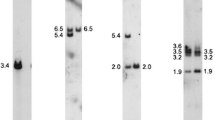Abstract.
To contribute to the creation of a transcription map of human chromosome 21 (HC21) and to the identification of genes that may be involved in the pathogenesis of Down syndrome, exon trapping was performed from HC21-specific cosmids covering the entire chromosome. More than 700 exons have been identified to date. One such exon, hmc01a06, maps to YAC 831B6 which contains marker D21Z1 (alphoid repeats) and had previously been localized to the pericentromeric region of HC21. Northern-blot analysis revealed a 2.5-kb mRNA species strongly and exclusively expressed in the testis. We cloned the corresponding full-length cDNA, which encodes a predicted polypeptide of 551 amino acids with at least two potential transmembrane domains and a tyrosine phosphatase motif. The cDNA has sequence homology to chicken tensin, bovine auxilin and rat cyclin-G associated kinase (GAK). The entire polypeptide sequence also has significant homology to tumor suppressor PTEN/MMAC1 protein. We termed this novel gene/protein TPTE (transmembrane phosphatase with tensin homology). Polymerase chain reaction amplification, fluorescent in situ hybridization, Southern-blot and sequence analysis using monochromosomal somatic cell hybrids showed that this gene has highly homologous copies on HC13, 15, 22, and Y, in addition to its HC21 copy or copies. The estimated minimum number of copies of the TPTE gene in the haploid human genome is 7 in male and 6 in female. Zoo-blot analysis showed that TPTE is conserved between humans and other species. The biological function of the TPTE gene is presently unknown; however, its expression pattern, sequence homologies, and the presence of a potential tyrosine phosphatase domain suggest that it may be involved in signal transduction pathways of the endocrine or spermatogenetic function of the testis. It is also unknown whether all copies of TPTE are functional or whether some are pseudogenes. TPTE is, to our knowledge, the gene located closest to the human centromeric sequences.
Similar content being viewed by others
Author information
Authors and Affiliations
Additional information
Electronic Publication
Rights and permissions
About this article
Cite this article
Chen, H., Rossier, C., Morris, M. et al. A testis-specific gene, TPTE, encodes a putative transmembrane tyrosine phosphatase and maps to the pericentromeric region of human chromosomes 21 and 13, and to chromosomes 15, 22, and Y. Hum Genet 105, 399–409 (1999). https://doi.org/10.1007/s004399900144
Received:
Accepted:
Issue Date:
DOI: https://doi.org/10.1007/s004399900144




